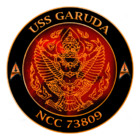Garuda Technical Overview: Difference between revisions
No edit summary |
|||
| Line 62: | Line 62: | ||
===Auxiliary Spacecraft Systems=== | ===Auxiliary Spacecraft Systems=== | ||
* ''' | * '''Approximate Auxiliary Craft Complement:''' 40 | ||
* ''' | ** '''Shuttlepods:''' 12 | ||
* '''Runabouts:''' 2 ''Danube'' class runabouts | ** '''Personal Shuttles:''' 10 | ||
* '''Specialist Craft:''' Captain's yacht | *** 5 Type IX short range shuttles | ||
*** 5 Type XI long range shuttles | |||
** '''Runabouts:''' 2 ''Danube'' class runabouts | |||
** '''Cargo Shuttles:''' 10 | |||
** '''Specialist Craft:''' 5 | |||
*** 1 Captain's yacht | |||
*** 2 ''Sphinx'' workpods | |||
*** 3 workbees | |||
* '''Emergency Evacuation Systems/Escape Pods:''' 2700 Type IX Autonomous Survival and Recovery Vehicles (ASRV) | * '''Emergency Evacuation Systems/Escape Pods:''' 2700 Type IX Autonomous Survival and Recovery Vehicles (ASRV) | ||
Revision as of 12:36, 28 July 2014
| USS Garuda | ||
|---|---|---|
 INACTIVE STATUS | ||
| ||
The USS Garuda, NCC-73809, was commissioned following the conclusion of the Dominion War in 2375 and launched in 2379. She, along with her sister ships from the 73XXX run of the Galaxy class, was designed to include updated technology — with further potential for upgrades — along with a specific focus upon scientific and cultural exploration, even more so than her predecessors. As such, the Garuda has laboratories scattered throughout her saucer and stardrive sections, including those devoted to the biological, chemical, and physical sciences; history, anthropology, archaeology, sociology, and psychology; planetary science, geoscience, and astronomy; theoretical and analytical computer sciences; and experimental engineering and technology (R&D) facilities. Furthermore, her sickbay is state-of-the-art, including not only emergency, intensive care, and surgical wards but also medical research and technologies.
Built in the post-Dominion era, the Garuda’s tactical systems have been upgraded since the class’s initial launch in 2357; she has a slightly higher warp cruising speed of warp 7; and her burst-fire photon torpedo tubes have been replaced with pulse-fire quantum torpedo tubes. In short, the Garuda is perfectly designed to be the mobile research platform necessary for further exploration of the Menthar Corridor and beyond, but comes equipped with the defensive and offensive technology necessary to confront any hostile forces her crew may encounter on the frontier.
Overview
- Class: Galaxy
- Registration: NCC-73809
- Type: Explorer
- Production Base: Utopia Planitia Fleet Yards, Mars
- Commissioned: 2375
- Launched: 2379
Physical Specifications
- Length: 641m
- Beam: 470m
- Height: 145m
- Mass: 4,960,000t
- Hull: Standard duranium microfoam and tritanium plating double hull, with 9.0cm high density armour.
- Decks: 42
Crew Complement
- Officers: 375
- Enlisted: 625
- Total: 1000
- Maximum Evacuation Capacity: 15,000
Computer Systems
- Hardware: Class XIX Bioneural/Isolinear processing units, three independent computer cores
- Operating System: Library Computer Access and Retrieval System (LCARS)
Propulsion Systems
- Impulse: Three FIG 6 Subatomic Unified Energy Impulse Units, two located on the saucer section, one on the stardrive section
- Warp: LF-45 Advanced Linear Warp Drive Unit
- Standard Cruise Speed: 7
- Maximum Sustainable Cruise Speed: 9.75
- Maximum Speed: 9.99 (18 hours)
Tactical Systems
- Phasers: Twelve Type XII collimated phaser arrays
- One array is located on the stardrive section and can only be used when the ship is separated.
- Torpedoes: Three Type III pulse-fire torpedo tubes
- One rearward-facing launcher is located on the saucer section and can only be fired when the ship is separated.
- Standard Load-out: 200 Type VI quantum torpedoes, 100 Type X photon torpedoes
- Deflector Shields: 10 high capacity, regenerative oscillating subspace graviton field grids with recursive response analysis.
- Tractor Beams: One tractor beam emitter, aft ventral hull, stardrive section.
Crew Support Systems
- Medical: Primary sickbay located in the saucer section, with three wards, a surgical suite, an intensive-care unit (ICU), biohazard support, morgue and several medical laboratories. Secondary sickbay located in the stardrive section with one ward, a small surgical suite, ICU and morgue.
- Holographic Support: Emergency Medical Holgraphic Emitters installed in all medical facilities.
- Education: Nursery and additional classrooms as required.
- Recreational: 16 holodecks (25 man capacity), mess hall, crew lounge, gymnasium and additional reconfigurable recreational halls.
Transporter Systems
- Personnel: 6 transporter rooms with a 6 man capacity per transporter.
- Cargo: 4 cargo transporters with a 500t capacity per transport.
Cargo Systems
- Total Capacity: Mission dependant. Several sections of the Galaxy class are designed to be highly reconfigurable and can be easily rededicated according to mission requirements.
Auxiliary Spacecraft Systems
- Approximate Auxiliary Craft Complement: 40
- Shuttlepods: 12
- Personal Shuttles: 10
- 5 Type IX short range shuttles
- 5 Type XI long range shuttles
- Runabouts: 2 Danube class runabouts
- Cargo Shuttles: 10
- Specialist Craft: 5
- 1 Captain's yacht
- 2 Sphinx workpods
- 3 workbees
- Emergency Evacuation Systems/Escape Pods: 2700 Type IX Autonomous Survival and Recovery Vehicles (ASRV)
Maintenance
- Expected Duration: 95 years
- Resupply Cycle: 1 year
- Minor Refit Cycle: 5 years
- Standard Refit Cycle: 10 years
- Major Refit Cycle: 20 years

